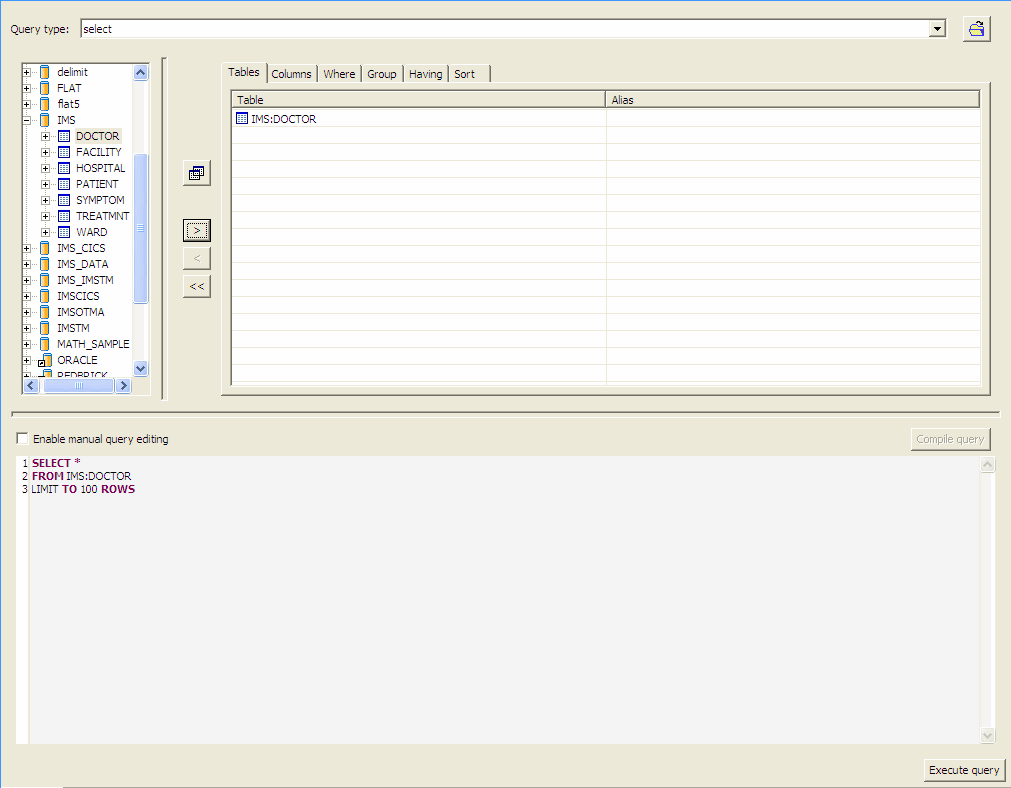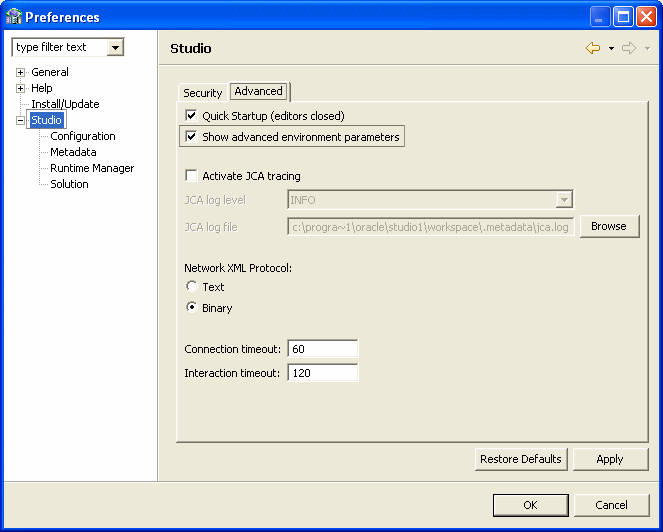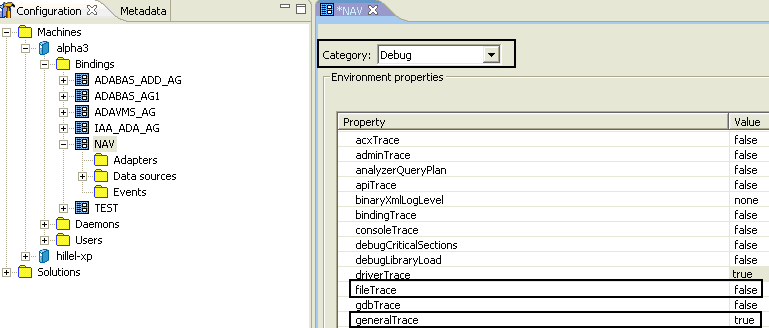Log files are used for troubleshooting and error handling. The log file is generated when the driverTrace debug binding parameter is set to True.
The log file includes various information concerning the functions used or called by the driver, queries executed, data sources accessed, etc.
First, you need to create the log file. Perform the following procedure.
Example 7-1 Sample IMS Log File
ORACLE CONNECT Log (V10.1.3.1, MVS) Started at 2006-12-04T17:57:33
Licensed by Oracle Corporation on 28-SEP-2006 (001001610)
Licensed to ORACLE for <all providers> on <all machines> (<all platforms>)
o: 586 9991834 fopen >>> filename=TEST.OR5000A.DEF.NOSBB.SYS,mode=rb, typ
e=record, lrecl=8208
o: 275 0 flocate >>> stream=9991834,key=99CA6C8,key_len=4,options=3
o: 292 8208 fread >>> buffer=99CB1A8, size=1, count=8208,stream=9991834
o: 424 0 fclose >>> stream=9991834
o: 275 0 flocate >>> stream=997C3F4,key=9974ED0,key_len=100,options=5
o: 292 2048 fread >>> buffer=99746C8, size=1, count=2048,stream=997C3F4
o: 275 0 flocate >>> stream=997C024,key=9974ED0,key_len=4,options=5
o: 292 2048 fread >>> buffer=99746C8, size=1, count=2048,stream=997C024
o: 275 0 flocate >>> stream=997C3F4,key=9974ED0,key_len=100,options=5
o: 292 2048 fread >>> buffer=99746C8, size=1, count=2048,stream=997C3F4
o: 275 0 flocate >>> stream=997C024,key=9974ED0,key_len=4,options=5
o: 292 2048 fread >>> buffer=99746C8, size=1, count=2048,stream=997C024
SYSBASE (699): ; REGENTP(db_ims_d) returned 0
SYSBASE (640): ; dllload(NVDBIMS) returned 8ED5A67
SYSBASE (650): ; dllqueryfn(8ED5A67, db_ims_dli_get_functions) returned 8ED5A90
<IMSDB DP> >>> CONNECT connect=''
<IMSDB DP> <<< CONNECT 0
<IMSDB DP> >>> SET CONNECT transaction type == '0'
<IMSDB DP> <<< SET CONNECT 0
nvOUT (PROD.AC10131.NAV(QP#SQTXT) 89): SELECT TABLE_NAME, TABLE_TYPE FROM NAV_PROC:SP_TABLES('ims', '%', '%', 'TABLE,SYSTEM TABLE,
VIEW,SYNONYM', 0)
nvRETURN (PROD.AC10131.NAV(QPSYNON) 1140): -1
<<<<<<<<<<<<<<<<<<< Execution Strategy Begin <<<<<<<<<<<<<<<<<<<<<<<<<<<<
Original SQL:
SELECT TABLE_NAME , TABLE_TYPE FROM NAV_PROC : SP_TABLES ( 'ims' , '%' , '%' , 'TABLE,SYSTEM TABLE,VIEW,SYNONYM' , 0 )
Accessing saved query spec SP_TABLES()
from NAV_PROC DB
>>>>>>>>>>>>>>>>>>>> Execution Strategy End >>>>>>>>>>>>>>>>>>>>>>>>>>>>
o: 586 9991834 fopen >>> filename=TEST.OR5000A.DEF.NOS.IMS,mode=rb, type=
record, lrecl=2048
o: 393 0 fclose >>> stream=997C3F4
o: 424 0 fclose >>> stream=997C024
o: 586 Calling ENQ for TEST.OR5000A.DEF.NOS.SYS .
o: 586 Successful exclusive enqueue retCode=0
o: 586 9991C04 fopen >>> filename=TEST.OR5000A.DEF.NOS.SYS,mode=rb+, type
=record
o: 627 997C024 fopen >>> filename=TEST.OR5000A.DEF.NOS.SYS.I2.PATH,mode=r
b, type=record, lrecl=2048
o: 275 0 flocate >>> stream=997C024,key=9C13F50,key_len=100,options=5
o: 292 2048 fread >>> buffer=9C13748, size=1, count=2048,stream=997C024
o: 393 0 fclose >>> stream=997C024
o: 424 0 fclose >>> stream=9991C04
o: 424 Calling DEQ for TEST.OR5000A.DEF.NOS.SYS
o: 424 Successful dequeue retCode=0
o: 586 997C024 fopen >>> filename=TEST.OR5000A.DEF.NOS.IMS,mode=rb, type=
record, lrecl=2048
o: 586 Calling ENQ for TEST.OR5000A.DEF.NOS.SYS .
o: 586 Successful exclusive enqueue retCode=0
o: 586 997C3F4 fopen >>> filename=TEST.OR5000A.DEF.NOS.SYS,mode=rb+, type
=record
o: 627 997C7C4 fopen >>> filename=TEST.OR5000A.DEF.NOS.SYS.I2.PATH,mode=r
b, type=record, lrecl=2048
o: 275 0 flocate >>> stream=997C7C4,key=9C08F30,key_len=100,options=5
o: 292 2048 fread >>> buffer=9C08728, size=1, count=2048,stream=997C7C4
o: 393 0 fclose >>> stream=997C7C4
o: 424 0 fclose >>> stream=997C3F4
o: 424 Calling DEQ for TEST.OR5000A.DEF.NOS.SYS
o: 424 Successful dequeue retCode=0
o: 627 997C3F4 fopen >>> filename=TEST.OR5000A.DEF.NOS.IMS.I2.PATH,mode=r
b, type=record, lrecl=2048
o: 275 0 flocate >>> stream=997C3F4,key=9C04ED0,key_len=100,options=5
o: 292 2048 fread >>> buffer=9C046C8, size=1, count=2048,stream=997C3F4
o: 292 2048 fread >>> buffer=9C046C8, size=1, count=2048,stream=997C3F4
o: 292 2048 fread >>> buffer=9C046C8, size=1, count=2048,stream=997C3F4
o: 292 2048 fread >>> buffer=9C046C8, size=1, count=2048,stream=997C3F4
o: 292 2048 fread >>> buffer=9C046C8, size=1, count=2048,stream=997C3F4
o: 292 2048 fread >>> buffer=9C046C8, size=1, count=2048,stream=997C3F4
o: 292 2048 fread >>> buffer=9C046C8, size=1, count=2048,stream=997C3F4
o: 292 0 fread >>> buffer=9C046C8, size=1, count=2048,stream=997C3F4
o (292): ; amrc: Error = 81704
AbendSyscode = 8
AbendRc = 1704
FdbkRc = 8
Ftncd = 17
Fdbk = 4
svc99_info = 8
svc99_error = 1704
RBA = 0
last_op = 72
o (292): ; amrc: msg=NULL
DB_VSAM_IO (302): ; amrc: Error = 81704
AbendSyscode = 8
AbendRc = 1704
FdbkRc = 8
Ftncd = 17
Fdbk = 4
svc99_info = 8
svc99_error = 1704
RBA = 0
last_op = 6
DB_VSAM_IO (302): ; amrc: msg=NULL
DB_VSAM_IO (302): ;
DB_VSAM_IO(302) io_vsam_get
End of file
o: 586 997CFDC fopen >>> filename=TEST.OR5000A.DEF.NOS.IMS,mode=rb, type=
record, lrecl=2048
o: 586 Calling ENQ for TEST.OR5000A.DEF.NOS.SYS .
o: 586 Successful exclusive enqueue retCode=0
o: 586 997D3AC fopen >>> filename=TEST.OR5000A.DEF.NOS.SYS,mode=rb+, type
=record
o: 627 997DAAC fopen >>> filename=TEST.OR5000A.DEF.NOS.SYS.I2.PATH,mode=r
b, type=record, lrecl=2048
o: 275 0 flocate >>> stream=997DAAC,key=9BFEF10,key_len=100,options=5
o: 292 2048 fread >>> buffer=9BFE708, size=1, count=2048,stream=997DAAC
o: 393 0 fclose >>> stream=997DAAC
o: 424 0 fclose >>> stream=997D3AC
o: 424 Calling DEQ for TEST.OR5000A.DEF.NOS.SYS
o: 424 Successful dequeue retCode=0
o: 627 997D3AC fopen >>> filename=TEST.OR5000A.DEF.NOS.IMS.I2.PATH,mode=r
b, type=record, lrecl=2048
o: 275 -1 flocate >>> stream=997D3AC,key=9C0AF50,key_len=100,options=5
o (275): ; amrc: Error = 81704
AbendSyscode = 8
AbendRc = 1704
FdbkRc = 8
Ftncd = 17
Fdbk = 4
svc99_info = 8
svc99_error = 1704
RBA = 0
last_op = 74
o (275): ; amrc: msg=NULL
nvOUT (PROD.AC10131.NAV(QP#SQTXT) 89): select * from doctor
nvRETURN (PROD.AC10131.NAV(QPSYNON) 1140): -1
o: 275 0 flocate >>> stream=997C3F4,key=9C04ED0,key_len=100,options=5
o: 292 2048 fread >>> buffer=9C046C8, size=1, count=2048,stream=997C3F4
o: 275 0 flocate >>> stream=997C024,key=9C04ED0,key_len=4,options=5
o: 292 2048 fread >>> buffer=9C046C8, size=1, count=2048,stream=997C024
o: 586 997EADC fopen >>> filename=TEST.OR5000A.DEF.NOSBB.IMS,mode=rb, typ
e=record, lrecl=8208
o: 275 0 flocate >>> stream=997EADC,key=9C58818,key_len=4,options=3
o: 292 8208 fread >>> buffer=9C591B0, size=1, count=8208,stream=997EADC
o: 424 0 fclose >>> stream=997EADC
<<<<<<<<<<<<<<<<<<< Execution Strategy Begin <<<<<<<<<<<<<<<<<<<<<<<<<<<<
Original SQL:
select * from doctor
Accessing file 'doctor' from 'ims' Database
Fetch strategy: scan
>>>>>>>>>>>>>>>>>>>> Execution Strategy End >>>>>>>>>>>>>>>>>>>>>>>>>>>>
<IMSDB DP> >>> OPEN_STREAM DOCTOR
<IMSDB DP> <<< OPEN_STREAM status=0, stream=1
<IMSDB DP> >>> SEND_RECEIVE DOCTOR stream=1, keyLen=26, recLen=80
<IMSDB DP> >>> lastPCB=-1, cPCBs=1, PCBs=0
<IMSDB DP> >>> readahead=282, cSSAs=2
<IMSDB DP> >>>> READ HOSPITAL
<IMSDB DP> >>>> DOCTOR
DLIPLUG Request:
09C90410 | 00000000C4D6C3E3D6D9404000010000 | ....DOCTOR ....
09C90420 | 0000000000000000000000000000FF00 | ................
09C90430 | 0000001A000000500000000000000000 | .......&........
09C90440 | 0000000000000000000000000000011A | ................
09C90450 | 02000000000000000000000000000000 | ................
09C90460 | 000000000000001A0000000000000000 | ................
09C90470 | 00000000000000000000000000000000 | ................
09C90480 | 0000C8D6E2D7C9E3C1D3000000000000 | ..HOSPITAL......
09C90490 | 0000C4D6C3E3D6D94040000000000000 | ..DOCTOR ......
09C904A0 | 0000 | ..
CTDLI(2,GU ,HOSPITAL ,DOCTOR )
GU , DBD(HOSPDBD ), Segment(DOCTOR ), SSA1(HOSPITAL ), SSA2(DOCTOR ),
Buffer(Jane Doe Behind the fireplace 392-600359Urology
), Status( ), RC(0), KFB(Spalding
Rehabilitat2 017 )
CTDLI(2,GN ,HOSPITAL ,DOCTOR )
GN , DBD(HOSPDBD ), Segment(DOCTOR ), SSA1(HOSPITAL ), SSA2(DOCTOR ),
Buffer(Miki Mouse Next to fireplace 424-337760Trauma & o
), Status( ), RC(0), KFB(Swedish Medical
1 041 )
CTDLI(2,GN ,HOSPITAL ,DOCTOR )
GN , DBD(HOSPDBD ), Segment(DOCTOR ), SSA1(HOSPITAL ), SSA2(DOCTOR ),
Buffer(Yetti Bigfoot Next to fireplace 392-693961Ear, nose
), Status( ), RC(0), KFB(Presbyterian/St.
Luke1 059 )
CTDLI(2,GN ,HOSPITAL ,DOCTOR )
GN , DBD(HOSPDBD ), Segment(DOCTOR ), SSA1(HOSPITAL ), SSA2(DOCTOR ),
Buffer(Blonde Genius Next to fireplace 723-135562Ophthalmol
), Status( ), RC(0), KFB(Presbyterian/St.
Luke2 060 )
CTDLI(2,GN ,HOSPITAL ,DOCTOR )
GN , DBD(HOSPDBD ), Segment(DOCTOR ), SSA1(HOSPITAL ), SSA2(DOCTOR ),
Buffer(Gamma Tester Next to fireplace 974-800964Oral surge
), Status( ), RC(0), KFB(Good Samaritan
1 061 )
CTDLI(2,GN ,HOSPITAL ,DOCTOR )
GN , DBD(HOSPDBD ), Segment(DOCTOR ), SSA1(HOSPITAL ), SSA2(DOCTOR ),
Buffer(Dr. Verter Next to fireplace 297-497895Restorativ
), Status( ), RC(0), KFB(West Hills
Hospital 1 062 )
CTDLI(2,GN ,HOSPITAL ,DOCTOR )
GN , DBD(HOSPDBD ), Segment(DOCTOR ), SSA1(HOSPITAL ), SSA2(DOCTOR ),
Buffer(Art Next to fireplace 594-056510Paediatric
), Status( ), RC(0), KFB(Los Gatos
Surgical 1 064 )
CTDLI(2,GN ,HOSPITAL ,DOCTOR )
GN , DBD(HOSPDBD ), Segment(DOCTOR ), SSA1(HOSPITAL ), SSA2(DOCTOR ),
Buffer(Joe Canabis Next to fireplace 24-3377605Orthodonti
), Status( ), RC(0), KFB(Los Robles
Regional 1 095 )
CTDLI(2,GN ,HOSPITAL ,DOCTOR )
GN , DBD(HOSPDBD ), Segment(DOCTOR ), SSA1(HOSPITAL ), SSA2(DOCTOR ),
Buffer(Yoske Black Next to fireplace 92-6939616Neurosurge
), Status( ), RC(0), KFB(Los Robles
Regional 1 100 )
CTDLI(2,GN ,HOSPITAL ,DOCTOR )
GN , DBD(HOSPDBD ), Segment( ), SSA1(HOSPITAL ), SSA2(DOCTOR ),
Buffer(
), Status(GB), RC(51138), KFB()
DLIPLUG Response:
09C97960 | 40400000000000000000000900000001 | ..............
09C97970 | 00000000D181958540C4968540404040 | ....Jane Doe
09C97980 | 4040404040404040C2858889958440A3 | Behind t
09C97990 | 88854086899985979381838540404040 | he fireplace
09C979A0 | 404040404040F3F9F260F6F0F0F3F5F9 | 392-600359
09C979B0 | E49996939687A8404040404040404040 | Urology
09C979C0 | 40404040E29781938489958740D98588 | Spalding Reh
09C979D0 | 8182899389A381A3F240F0F1F740D489 | abilitat2 017 Mi
09C979E0 | 928940D496A4A2854040404040404040 | ki Mouse
09C979F0 | 4040D585A7A340A39640868999859793 | Next to firepl
09C97A00 | 81838540404040404040404040404040 | ace
09C97A10 | F4F2F460F3F3F7F7F6F0E39981A49481 | 424-337760Trauma
09C97A20 | 4050409640404040404040404040E2A6 | & o Sw
09C97A30 | 858489A28840D4858489838193404040 | edish Medical
09C97A40 | 4040F140F0F4F140E885A3A38940C289 | 1 041 Yetti Bi
09C97A50 | 87869696A340404040404040D585A7A3 | gfoot Next
09C97A60 | 40A39640868999859793818385404040 | to fireplace
09C97A70 | 40404040404040404040F3F9F260F6F9 | 392-69
09C97A80 | F3F9F6F1C581996B409596A285404040 | 3961Ear, nose
09C97A90 | 4040404040404040D79985A282A8A385 | Presbyte
09C97AA0 | 9989819561E2A34BD3A49285F140F0F5 | rian/St.Luke1 05
09C97AB0 | F940C2939695848540C7859589A4A240 | 9 Blonde Genius
09C97AC0 | 404040404040D585A7A340A396408689 | Next to fi
09C97AD0 | 99859793818385404040404040404040 | replace
09C97AE0 | 40404040F7F2F360F1F3F5F5F6F2D697 | 723-135562Op
09C97AF0 | 88A38881939496934040404040404040 | hthalmol
09C97B00 | 4040D79985A282A8A3859989819561E2 | Presbyterian/S
09C97B10 | A34BD3A49285F240F0F6F040C7819494 | t.Luke2 060 Gamm
09C97B20 | 8140E385A2A385994040404040404040 | a Tester
09C97B30 | D585A7A340A396408689998597938183 | Next to fireplac
09C97B40 | 8540404040404040404040404040F9F7 | e 97
09C97B50 | F460F8F0F0F9F6F4D699819340A2A499 | 4-800964Oral sur
09C97B60 | 878540404040404040404040C7969684 | ge Good
09C97B70 | 40E28194819989A38195404040404040 | Samaritan
09C97B80 | F140F0F6F140C4994B40E58599A38599 | 1 061 Dr. Verter
09C97B90 | 40404040404040404040D585A7A340A3 | Next t
09C97BA0 | 96408689998597938183854040404040 | o fireplace
09C97BB0 | 4040404040404040F2F9F760F4F9F7F8 | 297-4978
09C97BC0 | F9F5D985A2A3969981A389A540404040 | 95Restorativ
09C97BD0 | 404040404040E685A2A340C8899393A2 | West Hills
09C97BE0 | 40C896A29789A3819340F140F0F6F240 | Hospital 1 062
09C97BF0 | C199A340404040404040404040404040 | Art
09C97C00 | 40404040D585A7A340A3964086899985 | Next to fire
09C97C10 | 97938183854040404040404040404040 | place
09C97C20 | 4040F5F9F460F0F5F6F5F1F0D7818584 | 594-056510Paed
09C97C30 | 8981A399898340404040404040404040 | iatric
09C97C40 | D396A240C781A396A240E2A499878983 | Los Gatos Surgic
09C97C50 | 81934040F140F0F6F440D1968540C381 | al 1 064 Joe Ca
09C97C60 | 95818289A2404040404040404040D585 | nabis Ne
09C97C70 | A7A340A3964086899985979381838540 | xt to fireplace
09C97C80 | 404040404040404040404040F2F460F3 | 24-3
09C97C90 | F3F7F7F6F0F5D699A38896849695A389 | 377605Orthodonti
09C97CA0 | 40404040404040404040D396A240D996 | Los Ro
09C97CB0 | 829385A240D98587899695819340F140 | bles Regional 1
09C97CC0 | F0F9F540E896A2928540C29381839240 | 095 Yoske Black
09C97CD0 | 4040404040404040D585A7A340A39640 | Next to
09C97CE0 | 86899985979381838540404040404040 | fireplace
09C97CF0 | 404040404040F9F260F6F9F3F9F6F1F6 | 92-6939616
09C97D00 | D585A49996A2A4998785404040404040 | Neurosurge
09C97D10 | 40404040D396A240D996829385A240D9 | Los Robles R
09C97D20 | 8587899695819340F140F1F0F040 | egional 1 100
<IMSDB DP> <<< SEND_RECEIVE DOCTOR stream=1, status=' ', readahead=9, PCB=0,
flags=1
<IMSDB DP> >>> CLOSE_STREAM DOCTOR, stream=1
<IMSDB DP> <<< CLOSE_STREAM 0
nvRETURN (PROD.AC10131.NAV(DRVIUNWN) 804): -1210
(Last message occurred 3 times)
Disabled FilePool Cleanup(DB=___sys, FilePool Size=0)
Disabled FilePool Cleanup(DB=IMS, FilePool Size=0)
<IMSDB DP> >>> DISCONNECT
<IMSDB DP> <<< DISCONNECT
o: 393 0 fclose >>> stream=997C3F4
o: 424 0 fclose >>> stream=997C024
o: 424 0 fclose >>> stream=9991834
o: 393 0 fclose >>> stream=997D3AC
o: 424 0 fclose >>> stream=997CFDC
FilePool Shutdown(DB=___SYS, FilePool Size=0)
Closing log file at MON DEC 4 17:57:49 2006


